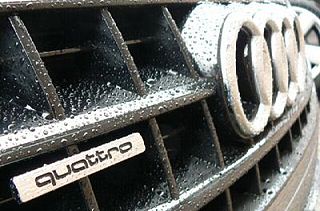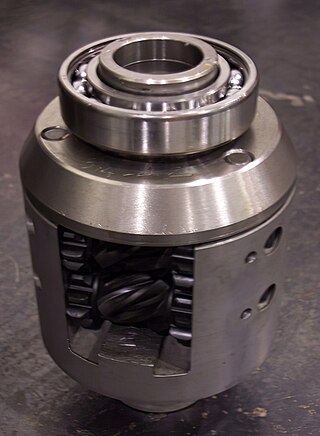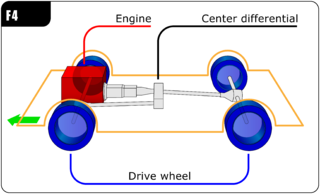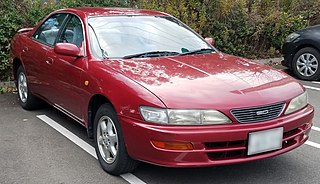
The Toyota Celica is an automobile produced by Toyota from 1970 until 2006. The Celica name derives from the Latin word coelica meaning heavenly or celestial. In Japan, the Celica was exclusive to the Toyota Corolla Store dealer chain. Produced across seven generations, the Celica was powered by various four-cylinder engines, and bodystyles included convertibles, liftbacks, coupés and notchback coupés.
A traction control system (TCS), is typically a secondary function of the electronic stability control (ESC) on production motor vehicles, designed to prevent loss of traction of the driven road wheels. TCS is activated when throttle input and engine power and torque transfer are mismatched to the road surface conditions.

The Toyota Supra is a sports car and grand tourer manufactured by the Toyota Motor Corporation beginning in 1978. The name "supra" is derived from the Latin prefix, meaning "above", "to surpass" or "go beyond".

A four-wheel drive, also called 4×4 or 4WD, is a two-axled vehicle drivetrain capable of providing torque to all of its wheels simultaneously. It may be full-time or on-demand, and is typically linked via a transfer case providing an additional output drive shaft and, in many instances, additional gear ranges.

Quattro is the trademark used by the automotive brand Audi to indicate that all-wheel drive (AWD) technologies or systems are used on specific models of its automobiles.

The Toyota Chaser is a mid-size car produced by Toyota. In the beginning, Chasers were four-door sedans and hardtop sedans; a two-door coupé was available only for the first generation. It was introduced on the 1976 Toyota Corona Mark II platform and was only available at Japanese Toyota Auto Store dealerships as the top-level model. The Chaser was produced for six generations; production ceased in 2001 when both it and the Cresta were replaced by the short-lived Verossa.
Toyota Motor Corporation's A family is a family of automatic FWD/RWD/4WD/AWD transmissions built by Aisin-Warner. They share much in common with Volvo's AW7* and Aisin-Warner's 03-71* transmissions, which are found in Suzukis, Mitsubishis, and other Asian vehicles.

Torsen Torque-Sensing is a type of limited-slip differential used in automobiles.

The Toyota Carina is an automobile which was manufactured by Toyota from December 1970 to December 2001. It was introduced as a sedan counterpart of the Celica, with which it originally shared a platform. Later, it was realigned to the Corona platform, but retained its performance image, with distinctive bodywork and interior — aimed at the youth market and remaining exclusive to Japanese Toyota dealerships Toyota Store. It was replaced in Japan by the Toyota Allion in 2001 and succeeded in Europe by the Toyota Avensis.

A viscous coupling is a mechanical device which transfers torque and rotation by the medium of a viscous fluid.

BMW xDrive is the marketing name for the all-wheel drive system found on various BMW models since 2003. The system uses an electronically actuated clutch-pack differential to vary the torque between the front and rear axles. Models with the DPC torque vectoring system also have a planetary gearset to overdrive an axle or rear wheel as required.
ATTESA is a four-wheel drive system used in some automobiles produced by the Japanese automaker Nissan, including some models under its luxury marque Infiniti.
Jeep uses a variety of four-wheel drive systems on their vehicles. These range from basic part-time systems that require the driver to move a control lever to send power to four wheels, to permanent four-wheel systems that monitor and sense traction needs at all four wheels automatically under all conditions.
Vehicles made by American Motors Corporation (AMC) and Jeep incorporated a variety of transmissions and transfer case systems. This article covers transmissions used in the following vehicle models and years:
ControlTrac four-wheel drive is the brand name of a selectable automatic full-time four-wheel drive system offered by Ford Motor Company. The four-wheel drive system was designed and developed at BorgWarner under its TorqTransfer Systems division in the mid 1980s. BorgWarner calls the system Torque-On-Demand (TOD). ControlTrac was the first automatic system to use software control and no planetary or bevel geared center differential. Instead of a planetary or bevel geared center differential, the system uses a variable intelligent locking center multi-disc differential.

The Toyota Celica GT-Four is a high performance model of the Celica Liftback that was produced from 1986 to 1999, with a turbocharged 3S-GTE engine, and full-time AWD. It was created to compete in the World Rally Championship, whose regulations dictate that a manufacturer must build road-going versions of the vehicle in sufficient numbers. These vehicles are referred to as "homologation special vehicles".

In automotive design, an F4, or front-engine, four-wheel drive (4WD) layout places the internal combustion engine at the front of the vehicle and drives all four roadwheels. This layout is typically chosen for better control on many surfaces, and is an important part of rally racing, as well as off-road driving. In terms of racing purposes, whether it be on-road or off-road, can be described as follows,
A team that pursues the Weak LS4WD architecture will minimize the development cost of the front-wheel drive system at the expense of having a larger rear powertrain. The Weak architecture produces a vehicle with a large powersplit between the front and rear powertrains, while the Strong architecture recommends a vehicle with more similar power and torque requirements for the front and rear.
All Wheel Control (AWC) is the brand name of a four-wheel drive (4WD) system developed by Mitsubishi Motors. The system was first incorporated in the 2001 Lancer Evolution VII. Subsequent developments have led to S-AWC (Super All Wheel Control), developed specifically for the new 2007 Lancer Evolution. The system is referred by the company as its unique 4-wheel drive technology umbrella, cultivated through its motor sports activities and long history in rallying spanning almost half a century.

The Toyota Carina ED is a compact car manufactured by Japanese automaker Toyota in 1985 as a companion to the 1984 Carina sedan. It was positioned as the four-door Celica, with a similar focus on luxury found on larger Toyota pillared hardtop sedans, like the Toyota Crown, the Toyota Mark II, Toyota Cresta and the Toyota Chaser.

The Symmetrical All-Wheel Drive is a full-time four-wheel drive system developed by the Japanese automobile manufacturer Subaru. The system consists of a longitudinally mounted boxer engine coupled to a symmetrical drivetrain with equal length half-axles. The combination of the symmetrical layout with a flat engine and a transmission balanced over the front axle provides optimum weight distribution with low center of gravity, improving the steering characteristics of the vehicle. Ever since 1986, most of the Subaru models sold in the international market are equipped with the SAWD system by default, with the rear wheel drive BRZ and kei cars as the exceptions.













